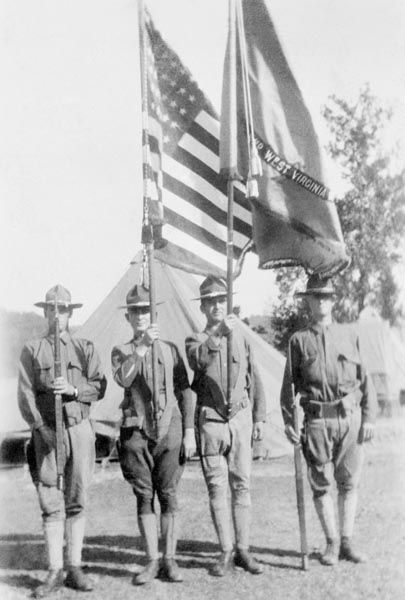West Virginians on the Mexican Border a Century Ago
By James E. Casto

The 2nd West Virginia Infantry color guard at Camp Kanawha, Charleston, 1916.
In 1916, Mexico was a country in turmoil. Venustiano Carranza was Mexico’s de facto president, but bandits and self-styled revolutionaries, such as Francisco “Pancho” Villa, actually ruled much of the countryside.
On March 9, 1916, on the orders of Villa, an armed force of 500 Mexicans attacked the little town of Columbus, New Mexico, which was garrisoned by a U.S. Army detachment. The attackers killed 10 residents and eight soldiers, burned part of the town, stole horses and mules, and seized guns and ammunition before fleeing back into Mexico.
The U.S. government reacted swiftly. President Woodrow Wilson designated General John J. Pershing, who would soon earn fame in World War I, to command a “Punitive Expedition.” Small Army units were immediately dispatched into Mexico to pursue Villa. Ultimately, Pershing commanded a force of more than 11,000 men.
However, an 11,000-man invasion of Mexico didn’t ease the fears of nervous U.S. residents along the Mexican border, who were worried about more attacks. In response, Wilson called into federal service more than 100,000 members of the National Guard from every state other than Nevada (which had no Guard unit at the time) and sent them to protect the border communities.
That’s how hundreds of West Virginia National Guardsmen found themselves in Texas. President Wilson’s order, issued on June 18, was delivered to Secretary of War Newton D. Baker, who incidentally was a native of Martinsburg. The call ultimately reached West Virginia Governor Henry Hatfield on the morning of June 19. Within five days, members of the West Virginia Guard had assembled at a hastily arranged mobilization camp in Kanawha City (now part of Charleston). The West Virginia Guard had a proud tradition, dating back to a militia company formed by Morgan Morgan in present Berkeley County in 1735. Most recently, the Guard had been called upon to quell the violence associated with the bloody Paint Creek-Cabin Creek coal mine strike in Kanawha County.
After Wilson’s call, Guardsmen from around Charleston marched to the camp; others arrived on special trains from across the state. One of the first orders of business was medical exams. Many men were rejected for being too old or too overweight for military service. The Huntington Advertiser reported that 56 men had fainted and were carried off on stretchers when subjected to the double ordeal of receiving vaccinations in both arms. The men suffered no lasting ill effects, the newspaper said.
At the time, the West Virginia Guard consisted of two infantry regiments. The federal mobilization order required that West Virginia furnish only one regiment. However, the West Virginia Guard was so undermanned that the state’s two regiments were rolled into one unit, designated as the Second Regiment. Even with two regiments combined, West Virginia still had an insufficient number of Guardsmen at its disposal.
Speculation ran high that the West Virginia troops would be on their way to the border in a matter of days, but that didn’t occur. Instead, the Guardsmen remained at Camp Kanawha for four months as recruiting efforts continued to bring the Second Regiment up to full strength. The National Guard also had to gather the necessary supplies and equipment, including basic items like clothing, which were in short supply. West Virginia Adjutant General John C. Bond complained of having to spend state funds to buy shoes, underwear, and other clothing.
Guard officers tried to keep the men busy with training exercises. The regiment carried out a two-day field march from Camp Kanawha to Spring Hill, located about 10 miles west in South Charleston. A planned four-day march to Clendenin in northern Kanawha County was canceled when the Department of War failed to authorize horses for the officers to ride.
On August 9, the drills took a tragic and unexpected turn when communities along Cabin Creek in eastern Kanawha County were hit by a severe flood. Five days later, the Coal River flooded at Racine in Boone County. The two floods killed more than 70 people and destroyed hundreds of homes. Guardsmen from Camp Kanawha were rushed to both disaster scenes, where they remained for two weeks, keeping order and aiding flood victims.
You can read the rest of this article in this issue of Goldenseal, available in bookstores, libraries or direct from Goldenseal.